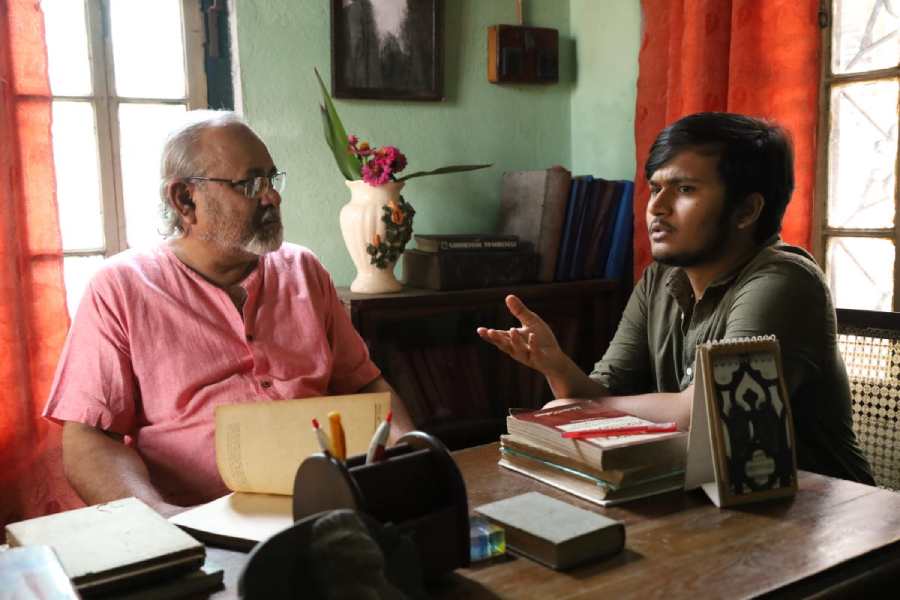It is not easy for a filmmaker to review a film, as many a time the filmmaker tends to look at the technical aspect of the film rather than the film itself. Let that be conceded first before this article goes into the details of Hemanter Aparanha, a Bengali full-length feature directed by Ashoke Viswanathan and running currently in halls in Calcutta. Ashoke has his own style of filmmaking, and Hemanter Aparanha is not much stylistically different from most of his earlier films.
Through this style, he has managed to create a whole new language of filmmaking, which is distinct and very different from the rest of his compatriots. Whether this style can please the audience at large is a different issue altogether, but Ashoke has proven time and again that he will be making movies only for the discerning, those who have a fair idea and exposure towards the overall art form of audio-visual storytelling.

Ashoke Viswanathan
Or, is it storytelling at all? The moot question still remains after someone watches the movie as the audience might ask, what is the story in the film?
Indian films, from time immemorial, have been rooted in telling a perfect story as Indians believe in hearing stories. This culture is deep-rooted and Indian cinema almost always prefers to toe this line of narrating a perfect story interspersed with sentiments of various shades.
Not Ashoke Viswanathan. Even if there is a story, his films will never go by the usual narrative of storytelling. Rather he would go by a non-narrative structure to make the storytelling complex and abstract so that the audience sits up and thinks and even forgets about gulping down the popcorn. Ashoke seriously thinks about only the serious audience, not the masses.
Take Hemanter Aparanha for example. If someone can finally make out the story in the film, it’s rather simple. Sudhin Babu (Satyapriyo) is a widower staying in the outskirts of the city all alone in quite a big house, probably which he inherited from his ancestors. His only son lives in Ukraine and doesn’t communicate with his father. In other words, he leads a rather boring life.

Rwitobroto Mukherjee in Hemanter Aparanha
A local theatre group suddenly approaches Sudhin to play a vital role in their upcoming stage production. Sudhin never had any previous experience in theatre, so he is nervous and sceptic. However, he goes to the theatre group’s rehearsals only to find a bunch of enthusiastic young people trying to stitch together a stage production. Another newcomer in the group is a young girl Papiya (Anusha Viswanathan) with whom Sudhin picks up a bonding — kind of a relationship one may say — though the nature of the relationship cannot be defined in conventional terms.
Then, when the theatre production is almost ready, the Covid pandemic begins and Sudhin is stuck at home. He sorely misses the rehearsals, the enthusiasm of the young people in the group, and of course Papiya. Finally, the lockdown is lifted and the theatre is staged. Not only many glitterati are seen in the front row of the theatre hall, but we also see Nati Binodini watching the theatre from the wings (an Ashoke style, of course). Though why Nati Binodini’s spirit would come to watch a Bengali adaptation of an Italian Nobel Laureate Pirandello’s play (Pirandello is often described as the forefather of the theatre of the absurd) remains a mystery, perhaps as mysterious as Nati Binodini’s life.
We have seen plenty of films which are often dubbed as a “film within a film”. In a way, Hemanter Aparanha can be called a “theatre within a film”. Maybe, that’s the reason most of the characters who act in the movie look somewhat unnatural, sometimes more theatrical than what one would expect in a film. Many actors seem to be struggling with the role they are playing. Sometimes, the actors are fitted into the structure of the film, rather than the actors becoming the characters in the film.
The interspersed abstractions, dream sequences and the “theatre of the absurd” have crept at various levels, which probably made the actors all the more shaky. Perhaps the structure and the non-narrative pattern of the film made the actors somewhat nervous. Were they real characters or unreal, many might have not found an easy answer to this.
Yet, a few young actors shine and make their presence felt. Rwitobroto Mukherjee is one example. Anusha not only looks good on screen, she seems to have the potential to go further. Meghla Dasgupta, within her limited screen space, has given a perfect performance. In many of the abstract dream sequences, Sohini Dasgupta, whom I have known as a director, is remarkable.

Director Subrata Sen has reviewed the series Chhotolokh on Zee5
The editing of the movie (Arghyakamal Mitra) is brilliant. It seemed to me that many loose ends in the movie were made up at the edit table. Special mention to Gaurab Chatterjee for creating a beautiful background score — very subtle and sparingly used, never carpet bombing — the way music in a film should be.
So, how do we conclude? Hemanter Aparanha is a movie which could have had a simple storyline. But, the director skilfully avoids a simple narrative structure in his endeavour to create a non-narrative that would create abstraction. Ashoke has not deviated from his well-known style. Probably he is the lone fighter in this form of film-making in contemporary India, somewhat like the fabled “Kumbha” who fought to protect “Boondi’s castle” a few centuries ago in Rajasthan.
Ashoke in his directorial note has himself described the film as “out of the box”. Probably he was also referring to the “box office” of the cinema halls. But box-office collection is not the only criteria to judge a movie. No way.











